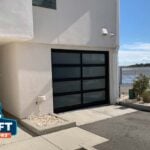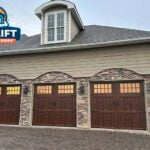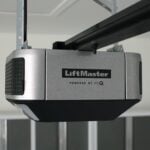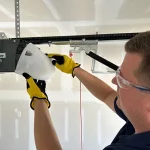
Dealing with a problematic garage door is a familiar challenge for many homeowners. Whether it’s the unsettling creak during early morning departures or the frustrating jolt when the door lurches open unexpectedly, these issues disrupt more than just convenience—they affect your daily routine and peace of mind. For those who take pride in DIY projects, tackling these annoyances head-on offers both a hands-on satisfaction and an opportunity to save on costly repairs.
Many small problems—like slightly misaligned tracks or rusty rollers—can escalate into significant headaches if left unattended. By addressing them early, you can avoid bigger future complications while extending the life of your garage door. So let’s dive in and explore these frequently encountered issues and their solutions.
Common Garage Door Problems
Your garage door is a hardworking piece of equipment, but it’s not invincible. Like any other mechanical system, it can run into various problems. Some of the most common issues include:
Door Not Opening or Closing Fully
This can be an inconvenience and a safety concern. It could be due to something as simple as an obstruction in the door’s path, or a more complex issue with the opener or motor.
An important thing to note is that garage doors have sensors designed to detect when there’s something blocking their path. If these sensors aren’t aligned properly, the door might struggle to open or close fully, leading to frequent interruptions and frustration for homeowners.
Uneven Opening
If you notice that your garage door opens unevenly, there may be an issue with the tracks or the balance of the door itself. This not only looks unsightly but can also indicate potential safety hazards if left unaddressed.
The tracks should be thoroughly inspected for any obstructions or misalignments, while the spring tension and balance of the door need to be checked to ensure smooth, even movement.
Unusual Noises
Unexpected sounds coming from your garage door can be alarming. They could indicate problems with the rollers, hinges, or other moving parts that require immediate attention.
Upon hearing strange noises, it’s crucial to investigate promptly. Ignoring such signs could lead to further damage and potentially increase the cost of repairs in the long run.
Now that we’ve identified some common issues that garage doors encounter, let’s explore how routine maintenance and inspections play a crucial role in identifying potential problems early on.

Troubleshooting Hardware Issues
When it comes to garage doors, issues with the hardware can be a real headache. But fear not, many of these problems can be resolved with a bit of DIY troubleshooting. Let’s start by looking at the rollers and hinges.
Misaligned Sensor
One common issue is a misaligned sensor causing the garage door to not close properly. To fix this, check the sensor alignment and adjust if necessary. Additionally, worn-out rollers can cause the door to operate noisily or unevenly – replacing them can resolve this issue. Always remember to consult a professional if you’re unsure about making adjustments to your garage door.
Checking the Rollers and Hinges
Rollers and hinges are like the joints and muscles of your garage door; when they wear out or get rusty, the door may start operating noisily or jerking in an unruly manner. To prevent this, you can simply use a silicone-based lubricant to keep everything running smoothly. It’s worth noting that regular maintenance like this can sometimes prevent damage before it becomes a major issue.
If you notice visible signs of damage or wear on the rollers and hinges, it might be time to replace them. A well-functioning garage door should move up and down effortlessly, so if you hear any screeching or thudding noises, it’s a good indication that the hardware needs some attention.
Regular inspection and upkeep of the rollers and hinges will not only improve the operation of your garage door but also extend the lifespan of these components.
Inspecting Bolts and Brackets
Another important aspect of garage door maintenance is inspecting the bolts and brackets. Over time, these essential components can become loose due to constant movement and vibration. Inadequately tightened hardware can lead to misalignment issues or, even worse, cause the door to fall off its tracks entirely.
To avoid such mishaps, it’s crucial to go over each bolt and bracket and ensure they are securely fastened. This simple check should ideally be part of your regular home maintenance routine and take only a few minutes, but it could save you from significant trouble down the line. By preventing misalignments or track accidents caused by loose hardware, you’re actively ensuring the safety and reliability of your garage door system.
Remember, prevention is better than cure. A proactive approach to maintaining the bolts and brackets can help you avoid disruptions in your daily routine caused by unexpected breakdowns or malfunctions in your garage door.
By keeping an eye on these details when troubleshooting your garage door—pay attention to how smoothly your door moves when you open/close it—you’ll notice potential issues with ease while also preventing more severe problems from manifesting down the line.
Now equipped with valuable knowledge about trouble-shooting common hardware issues in garage doors, it’s time to explore fixing electric opener problems.

Fixing Electric Opener Problems
An electric garage door opener is a modern convenience many of us can’t do without. It provides a sense of security and comfort, especially during inclement weather or late-night arrivals. With its sensors, motors, and power sources, there’s a lot that can go wrong with these systems. Here are some common issues and troubleshooting tips for fixing electric opener problems.
Replacing Batteries
One of the simplest but often overlooked problems is weak batteries in the remote opener. When the batteries are low, the remote may have intermittent connectivity issues. Replacing the remote opener’s batteries is a quick and easy fix that can solve many operational issues. Ensure to use high-quality batteries to avoid future malfunctions and inconvenience.
Quick Tip: Keep an eye on the strength of your batteries even if your remote is still functioning properly. Regularly changing them before they die completely can save you from unexpected inconvenience.
Checking the Motor
If the garage door opener’s motor makes a humming noise but doesn’t operate, it might be time to replace the motor capacitors. These small components are crucial for providing the necessary jolt of electricity that helps start the motor spinning. Over time, they can wear out, resulting in the motor struggling to start or not operating at all.
It’s essential to refer to your opener’s manual for the correct type of capacitors. Ensure that you turn off the power to the garage door opener before attempting any internal fixes or replacements. Safety should always come first when working with electrical components.
Pro Tip: If you’re not confident about identifying or replacing the motor capacitors, it’s best to call a professional to ensure that the job is done safely and correctly.
When addressing electric opener problems, it’s crucial to consider both simple solutions like battery replacement and more complex components like motor capacitors. These troubleshooting tips can help ensure that your garage door opener continues to function reliably and safely.
Addressing Cable and Spring Problems
The cables and springs in your garage door system work together to effectively open and close the door, taking on a significant amount of weight and tension in the process. It’s important to understand that these components play a key role in the overall operation of your garage door, which is why regular inspection, maintenance, and prompt attention to any issues are vital.
Now, let’s dive into the torsion springs. These springs carry a considerable portion of the door’s weight, making them crucial for its smooth operation. Over time, these torsion springs can wear out due to constant use. If one of these springs breaks, it can be extremely dangerous to repair or replace it on your own. The high tension in these springs means even a minor mistake during repair can result in serious injury or property damage. Thus, it’s highly recommended to seek the expertise of a professional technician who is trained in safely working with garage door components.
Additionally, an essential part of maintaining your garage door is checking the condition of its cables. These cables are critical for supporting the weight of the door and ensuring smooth movement along the track. However, like any moving parts, cables are subject to wear and tear over time. Frayed or worn-out cables can pose a significant risk as they may snap unexpectedly, potentially causing serious injury or property damage. Therefore, it is crucial to regularly inspect the cables for any visible signs of damage such as fraying or wearing. If such issues are detected, it is imperative to engage the services of a certified technician to replace the cables promptly and ensure that your garage door remains safe and functional.
Consider this: you notice some fraying on the cables and attempt to continue using the door without addressing this issue promptly. This decision might lead to severe consequences such as the cables snapping while the door is in motion, resulting in sudden and uncontrollable movement that can cause harm to anyone in its path or damage to vehicles or other property inside the garage.
Understanding the potential risks associated with neglected cable and spring maintenance underscores the importance of regular inspections and seeking professional assistance when needed. These preventive measures not only contribute to the safety and functionality of your garage door but also provide peace of mind knowing that potential hazards are being actively mitigated through proactive care and attention.
As we move forward, let’s now tackle another common problem that can impede your smooth entry into your garage: grappling with remote opener issues.
Solving Remote Opener Issues
Having a remote-controlled garage door opener brings great convenience, but encountering malfunctions can be quite frustrating. Let’s explore some common issues and how to troubleshoot them.
Reprogramming the Remote
One of the most common reasons for a malfunctioning remote is a loss of synchronization between the remote and the garage door opener. Luckily, reprogramming the remote is often a straightforward fix. Follow the specific steps outlined in your manual to reprogram your remote control. Generally, this may involve pressing a ‘Learn’ or ‘Program’ button on the main unit and then following instructions to press the open button on the remote. These steps help the opener recognize and synchronize with the remote control again.
Reprogramming your remote might sound daunting at first, but it’s usually quite simple and can save you from unnecessary frustrations caused by an unreliable garage door remote. It’s like resetting a password for your email – a little inconvenience now saves you from much larger headaches later.
Range Issues
If you find that your garage door remote only works when you are close to the garage and loses signal range, interference from other wireless devices could be the culprit. Wireless signals from other devices in or around your home can cause interference with your garage door opener’s signal.
In this case, it may be worth trying to change the frequency settings on the opener to resolve this issue. Some openers allow you to adjust the frequency they operate on to avoid those interferences.
Now, don’t worry if changing frequency sounds overly technical; many opener manuals provide clear step-by-step instructions on how to make frequency adjustments. Always remember to consult your manual as a first step when troubleshooting any issues with your garage door opener.
By following these troubleshooting steps, you’ll hopefully be able to resolve issues with your garage door opener’s remote control without having to call for repairs right away.
As we’ve tackled some of the common issues with garage door opener remotes, let’s now shift our focus to resolving tracking problems.
Resolving Tracking Problems
If your garage door is not moving smoothly or seems to be jammed in one position, the tracks may be the culprit. Over time, tracks can become misaligned or dirty, causing the door to function improperly. Addressing this issue requires a careful eye and a few simple tools.
Aligning the Tracks
The tracks play a critical role in guiding the movement of your garage door. Misaligned tracks are often the root cause of jamming or uneven movement. To realign the tracks:
- Use a Level: Place a level on each track to ensure they are straight and even.
- Loosen the Screws: If you notice any misalignment, loosen the screws holding the tracks in place to make adjustments.
Once the screws have been loosened, gently tap the tracks back into place without bending or damaging them. Proper alignment is essential for smooth and balanced operation of your garage door.
It’s crucial to check both the vertical and horizontal alignment of the tracks because even a small deviation from proper alignment can cause significant issues with the functionality of your garage door. By ensuring that the tracks are straight and parallel to each other, you can prevent unnecessary strain on the rollers and motor, prolonging the lifespan of your garage door system.
Cleaning the Tracks
In addition to proper alignment, keeping the tracks clean is essential for smooth operation. Dirt, debris, and residue can accumulate in the tracks over time, hindering roller movement.
Did You Know? A study found that 85% of tracking problems are caused by misaligned tracks.
Take a damp cloth and thoroughly clean inside the tracks, removing any buildup that may impede smooth movement. After cleaning, applying a small amount of lubricant along the track can help maintain smooth operation.
Regular cleaning and lubrication contribute to extending the overall lifespan of your garage door by preventing potential malfunctions and reducing strain on the motor and other components.
By addressing tracking problems through proper alignment and cleaning, you can ensure that your garage door operates smoothly and efficiently, minimizing potential issues and extending its longevity. Regular maintenance of these critical components is key to preventing more significant problems down the line.
A well-maintained garage door system is Essential
The security and functionality of your home rely on a well-maintained garage door system, making these troubleshooting tips essential for every homeowner.




